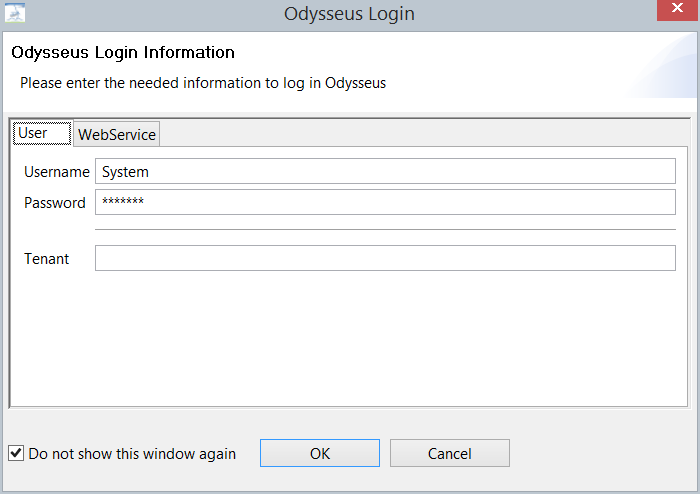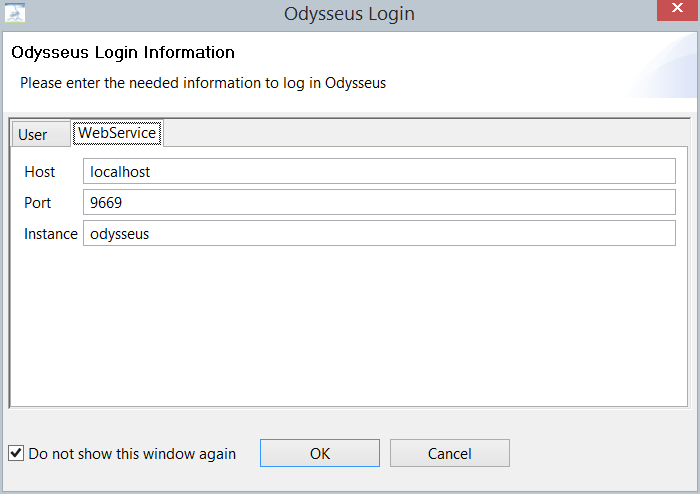This is a short tutorial that shows how to install Odysseus and how to setup the first time. This tutorial is for persons who just want to use Odysseus for data stream management. For those, who want to develop with Odysseus (e.g. create new operators or extend functionalities), may have a look at Development with Odysseus, which introduces how to import Odysseus into Eclipse.
1. Prerequisite
First, Java 7 (also known as Java 1.7) must be installed, which you can download here: http://www.java.com.
Since the installed Java version must not match with the one that Odysseus wants to use, Mac OS users may have a look here: Mac OS X and Java 7
2. Download Odysseus
Go to Odysseus Website to the Download section. You can choose between a stable version, which is stable but may not be the latest version, or you choose a nightly build which consits the latest fixes and is built each day at midnight. Choose the Version for your operating system in a 64 or 32 bit version. In our case, we have a 64 bit Windows 7 so that we choose Windowx x86 64 bit. Download the archive.
3. Unzip
Next, you have to unzip the archive. There is no installer nor a dedicated installation directory. Thus, you can choose a destination of your choice (In some cases, Odysseus does not behave correctly, if the installation path is to long. In this case try to install Odysseus to another location).
Remark: Under windows: Do not use folder program files.
Important: Do not use an existing directory, e.g. from an older Odysseus installation! If you want to update, see How to update Odysseus.
After unpacking, you may have something like the following:
4. Start Odysseus
Run "studio.exe" to start Odysseus.
5. Choose Workspace
At the first start, you have to choose a workspace. This workspace is a directory where all Odysseus projects will be stored.You can also check the "Use this as the default.." option so that this dialog will not pop up at the next start of Odysseus.
6. Login
Next, Odysseus asks you for a user and a password. The default user is "System" with password "manager". You can also check "Login automatically" so that username and password is saved and used automatically at the next start so you don't have to type in your login data again. In some cases there may be a field "Tenant". For most cases this field should be empty.
If you are using the client version of studio, the WebService tab must contain information about the Odysseus Server:
After that, Odysseus Studio starts, so you should the the interface:
That's all.
7. Next steps
You now can use Odysseus. Now, you can, for example, make yourself familiar with Odysseus Studio or you may create or import projects. For further steps, you may have a look at these pages:
- Odysseus Studio introduces the interface, views and commands
- Run Nexmark Example shows a tutorial how to run an example that is based on the Nexmark benchmark, including a data generator.
- Hands on Data Stream Processing shows different tutorials how Odysseus can be used in different projects - including special hardware
A. Hints if installation/start fails
- Java 1.7 (or sometimes called Java 7) has to be used. Although Java 1.7 was installed, it may happen that Java 1.6 is still used. Therefore, check if 1.7 is used. Check also, if JAVA_HOME is set correctly.
- On windows, you can check the version by open the command line to tool (go on "start", and "run" and enter "cmd", then press OK. In the command line enter "java -version" and hit enter. You should see some lines beginning with "java version "1.7.XXXX". if command is not found or another version is shown, check your Java installation.
On MacOS X, you may look at "B. Mac OS X and Java 1.7" in the next section.
- Be sure you downloaded the x86_64 version if you have a 64 bit operating system or the x86 version if you have a 32 bit operating system.
B. Mac OS X and Java 7
There are different problems with Java 7 on Mac OS X:
- On Mac OS X you may be asked for installing "Java 6 Runtime" when starting Odysseus using Studio.app. Since Odysseus needs Java 7 (aka 1.7), this won't work.
- On Mac OS X it may happen that Java 6 (1.6) is used (because you installed that before - e.g. after the error message mentioned obove), although you explicitly installed Java 1.7 (Java 7). This is because Mac OS may have different Java installations for different purposes (e.g. one for Apps, one for Terminal and so on...).
New (18.11.14): A solution for this problem can be found here: http://crunchify.com/os-x-mavericks-eclipse-java-issue/
If this does not work, try the following:
Since Odysseus is an App, you have to check which version is used for Apps by Mac OS. For this, open a new Terminal (use the spotlight to open it) and run the following command:
/usr/libexec/java_home -t BundledApp
This should print a path containing a number like ".../JavaVirtualMachines/1.7.0.jdk/...". If not or the path contains 1.6.0.jdk, your system does not use the correct Java version. Then, you can start Odysseus by using a comand. Go into the root folder of Odysseus (the one where the Studio.app is located) and enter the following command to start Odysseus:
java -Xms1000M -Xmx1000M -XstartOnFirstThread -jar plugins/org.eclipse.equinox.launcher_1.2.0.v20110502.jar --launcher.library plugins/org.eclipse.equinox.launcher.cocoa.macosx.x86_64_1.1.101.v20120109-1504 -console -nl en -data @noDefault -showsplash de.uniol.inf.is.odysseus.rcp.base -Dorg.eclipse.swt.internal.carbon.smallFonts -clean
C. Installation under Linux
You can install Odysseus either in your home directory (single user) or system wide (multi user).
Single User
To run Odysseus you need a Java runtime environment in version 7.
sudo aptitude install default-jre
Download and unzip the Odysseus package to your local bin folder
mkdir –p ~/bin wget –c http://odysseus.offis.uni-oldenburg.de/download/studio/stable/serverandstudio/odysseus.serverandstudio.gtk.linux.x86_64.zip -O ~/bin/odysseus.zip unzip odysseus.zip –d ~/bin
Add the Odysseus folder to your PATH variable
export PATH=~/bin/odysseus:$PATH
Multi User
To create an installable package for your system, download the package template and extract it. Inside the package, call the build shell script. The script downloads the current Odysseus studio and creates necessary files to bundle it as a Debian package.
wget http://odysseus.informatik.uni-oldenburg.de/download/products/build-debian.tar.gz tar xfz build-debian.tar.gz cd build-debian sh build
After the build, the bundle can be installed using the package manager.
dpkg -i odysseus-0.1.deb
D. Running Odysseus Server on Raspberry Pi, Beagleboard Black Rev C
The Odysseus server component works on a Raspberry Pi. Simple install a recent raspian first.
You should use a distinct user for odysseus.
After that, you should update/upgrade the system and install JavaJRE:
sudo apt-get update sudo apt-get upgrade sudo apt-get install openjdk-7-jre
Tip: With the console-command raspi-config you can configure your RaspberryPi/BananiPi further (e.g. keyboard layout)
The following script will download and install Odysseus as a server-component
wget http://odysseus.offis.uni-oldenburg.de/download/products/server/lastBuild/odysseus.server.gtk.linux.x86.zip unzip odysseus.server.gtk.linux.x86.zip
Alternatively, if multiple Odysseus-Instances should be connected (Peer-to-Peer-Network of RaspberryPi), you should download the Peer-Version of Odysseus:
wget http://odysseus.offis.uni-oldenburg.de/download/products/peer/lastBuild/odysseus.peer.gtk.linux.x86.zip unzip odysseus.peer.gtk.linux.x86.zip
The following script will execute Odysseus (Server-Version) with respect to restarts due to possible future updates (downloadable: http://odysseus.informatik.uni-oldenburg.de/download/products/server/startOdysseusServer )
wget http://odysseus.informatik.uni-oldenburg.de/download/products/server/startOdysseusServer chmod +x startOdysseusServer
#!/bin/bash cd odysseus.server.gtk.linux.x86 while true; do java -Xmx500M -Xms500M -Declipse.p2.mirrors=false -jar plugins/org.eclipse.equinox.launcher_1.2.0.v20110502.jar -console -debug -data @noDefault if [ "$?" != "23" ]; then break fi done
Attention: If you downloaded and installed the Peer-Version of Odysseus, you have to replace "server" with "peer" in the 3rd line (or download it from http://odysseus.informatik.uni-oldenburg.de/download/products/peer/startOdysseus).
Attention: The script-file must be made executable with chmod +x startOdysseus
wget http://odysseus.informatik.uni-oldenburg.de/download/products/peer/startOdysseus chmod +x startOdysseusServer
For the standard Beagle board "unzip" and "java" must be installed:
apt-get update apt-get install unzip apt-get install openjdk-7-jre // If multiple java versions are installed: choose the jdk to use. Must be at least java 7 update-alternatives --config java
Start same as above the raspberry.
Further devices tested:
- Cubiboard use e.g. http://www.igorpecovnik.com/2013/12/24/cubietruck-debian-wheezy-sd-card-image/
- Cubiboard 3 (Cubietrack), Image use e.g. http://www.igorpecovnik.com/2013/12/24/cubietruck-debian-wheezy-sd-card-image/
- Banana Pi
To start Odysseus automatically on startup, you have to edit the file /etc/inittab according to these instructions: http://elinux.org/RPi_Debian_Auto_Login
After that, append the line ./startOdysseus (or ./startOdysseusServer ) at the bottom of the file .bashrc of the user (e.g., /home/pi/.bashrc)




